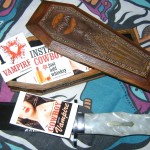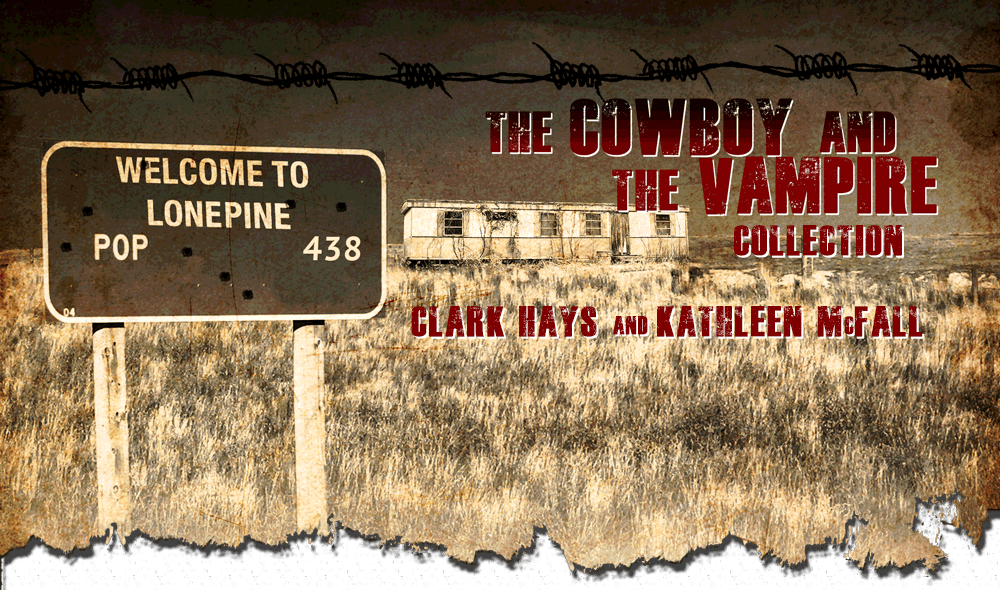Home > Soapbox > How we became die-curious
How we became die-curious
 Recently we bought our first coffin. No, we weren’t shopping for final accommodations to drop into side-by-side cemetery plots — fingers crossed, we’ve got a few decades left. Our first coffin is a tiny decorative number purchased online and delivered in 3 – 5 days. We bought it to hold business cards and freebie stickers splattered with blood (pictured) to give away at author events as we sell The Cowboy and the Vampire.
Recently we bought our first coffin. No, we weren’t shopping for final accommodations to drop into side-by-side cemetery plots — fingers crossed, we’ve got a few decades left. Our first coffin is a tiny decorative number purchased online and delivered in 3 – 5 days. We bought it to hold business cards and freebie stickers splattered with blood (pictured) to give away at author events as we sell The Cowboy and the Vampire.
We write about Vampires (Note: We also write about cowboys, but the existence of cowboys is not up for debate even though, sadly, it seems their numbers are dwindling). It’s a dark and noble calling that carries on a literary tradition stretching back to Poliodori’s The Vampyre (1819). And that’s just the literary tip of the iceberg. It’s likely the Vampires myth (hopefully it’s a myth) has been un-alive and well since humans first gathered around the fires and told stories about the shadowy monsters that must be responsible for all the evils things life threw at them — from mysterious diseases to death.
How the “die” was cast
We started working on The Cowboy and the Vampire about ten years ago as a means to test the potential strength of a resurrected relationship. The scars from the first few attempts were still fresh and a creative project seemed like a good way to find out if we had what it took for marriage.
Very little in our lives before The Cowboy and the Vampire indicated we would one day be poring over old books about murder, monsters and malice and spending sunny afternoons inside trying imagine what happens when a Vampire dies at sunrise or what it is about human blood they need to survive.
How did two generally happy, mostly well-balanced individuals come to spend an unhealthy amount of time thinking about death and skulking around in the shadowy parts of the psyche?
Library of the damned
We did not choose to write about Vampires, rather they chose us, reaching out with their pale, skeletal fingers from the pages of a thousand books.
Kathleen grew up in the shadow of Washington Cathedral in DC and perhaps can thank the soaring Gothic architecture for influencing her interests. She is intrigued by religion and the human tendency to construct and maintain intricate belief frameworks in part to explain what happens to the “self” after death. She also has researched near death experiences to understand the current scientific thinking about what happens neurologically at death when the brain shuts down.
Clark grew up on a ranch in Montana, surrounded by acres of silence. He filled that silence with a steady reading diet of sword and sorcery fantasy and horror masters. That morphed into a fascination with American Spiritualists starting with the passion and energy emanating from the Burned Over Region in the mid-1800s through mediums such as the Fox sisters and Daniel Home (check out Heyday of a Wizard) leading up to the skepticism at the turn of the century and the resurgence of interest after the staggering loss of life associated with World War I.
As we started working on The Cowboy and the Vampire, all of those books, avenues of inquiry and influences prompted us to dig deeply into the graveyard world of Vampires.
The post-death experience
Authors have been reinterpreting Vampires since the early greats formalized the archetype of the sinister, powerful, immortal creatures that feed upon, and project, our darkest fears. As homage to those early creators, we came up with something different in The Cowboy and the Vampire, blending religious fundamentalism with evolutionary biology reflecting the modern age in three ways:
First, for all their wisdom, strength and unique morality, our Vampires are shackled to a religious fervor just like humans. There are believers and non-believers, but their actions are always defined by or in response to ancient codas.
Second, our Vampires are shaped by evolution. It’s a much more gradual process because many of them have lived for centuries, even thousands of years, but the same biologic forces are in play. Vampires have an Achilles heel: sunlight. Because they die every dawn, humans have yet to be displaced as the dominant species on earth. Luckily for us, there’s a symbiotic balance between predator and prey, due to challenges associated with the way Vampire’s reproduce.
Third, our Vampires have unique spiritual lives. Because they die, completely, their bodies and brains shut down every morning. And yet they retain a unique, uninterrupted sense of self when they are resurrected at sunset. They experience a post-death experience, which we link to a shared external consciousness — the Vampire Cloud — that preserves their individual identities. They have the same kind of emotional and spiritual response as humans who have near death experiences, only every day.
We introduce all these themes in The Cowboy and the Vampire and examine them more deeply in Blood and Whiskey, coming in 2012.
Go toward the light
Spending all our time pondering death is ultimately life-affirming, prompting good conversation and allowing us to spend quality time together. The only downside is that we tend to get so focused on the creative work and the macabre world of Vampires, we forget to go outside.
That burning orb in the sky is punishing after spending all morning hunched over a computer writing, sketching out a plotline or wondering if Vampires that feed on humans with high cholesterol causes health concerns for the undead. (Note: we’re inclined so say cholesterol only changes the taste of human blood, making it a little too rich and buttery for most Vampires).
This post was first written for “Getting Naughty Between the Stacks.”
Like it? Got something to say? Do it on Facebook or send e-mail us at cowboyandvampire@gmail.com!
